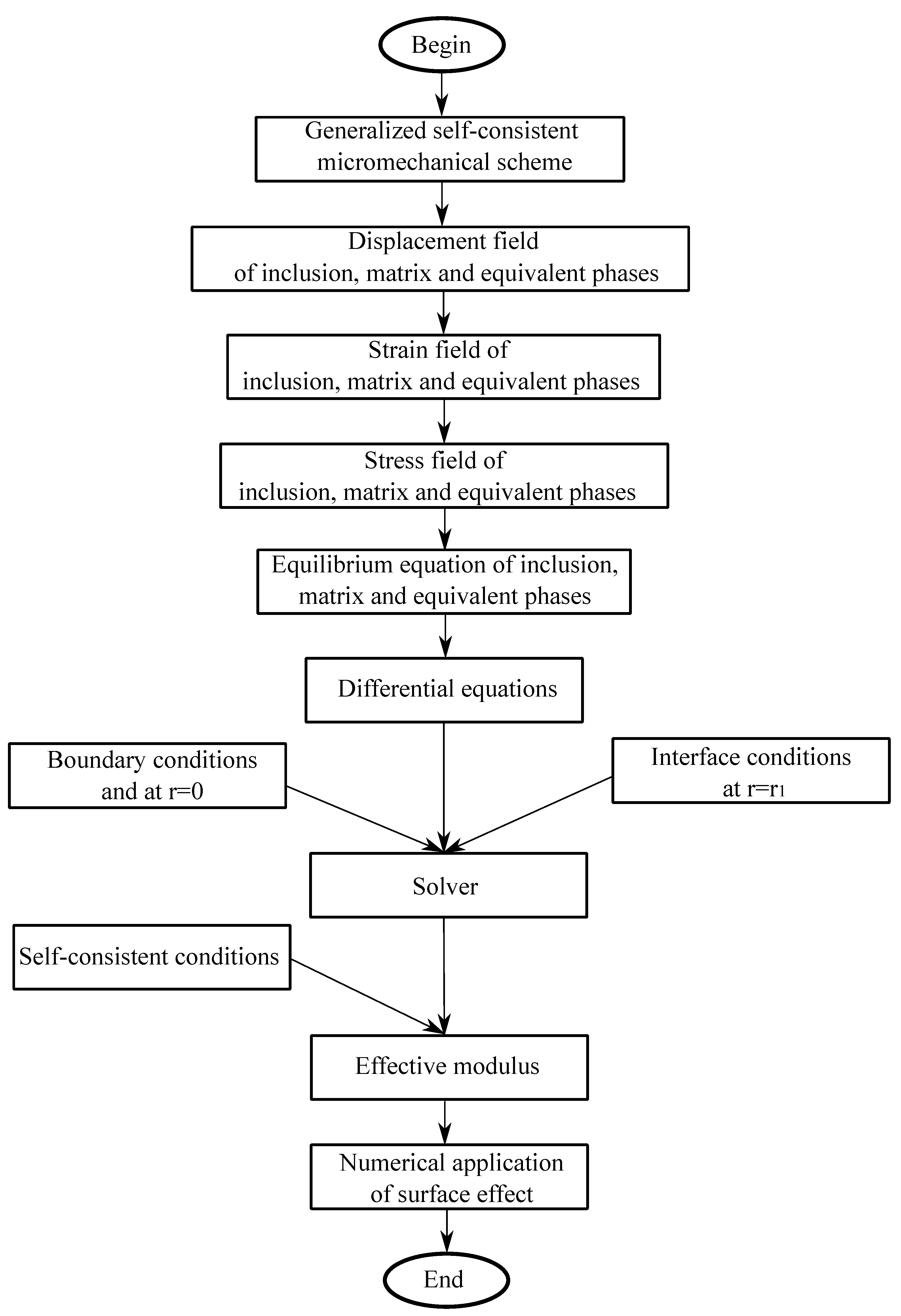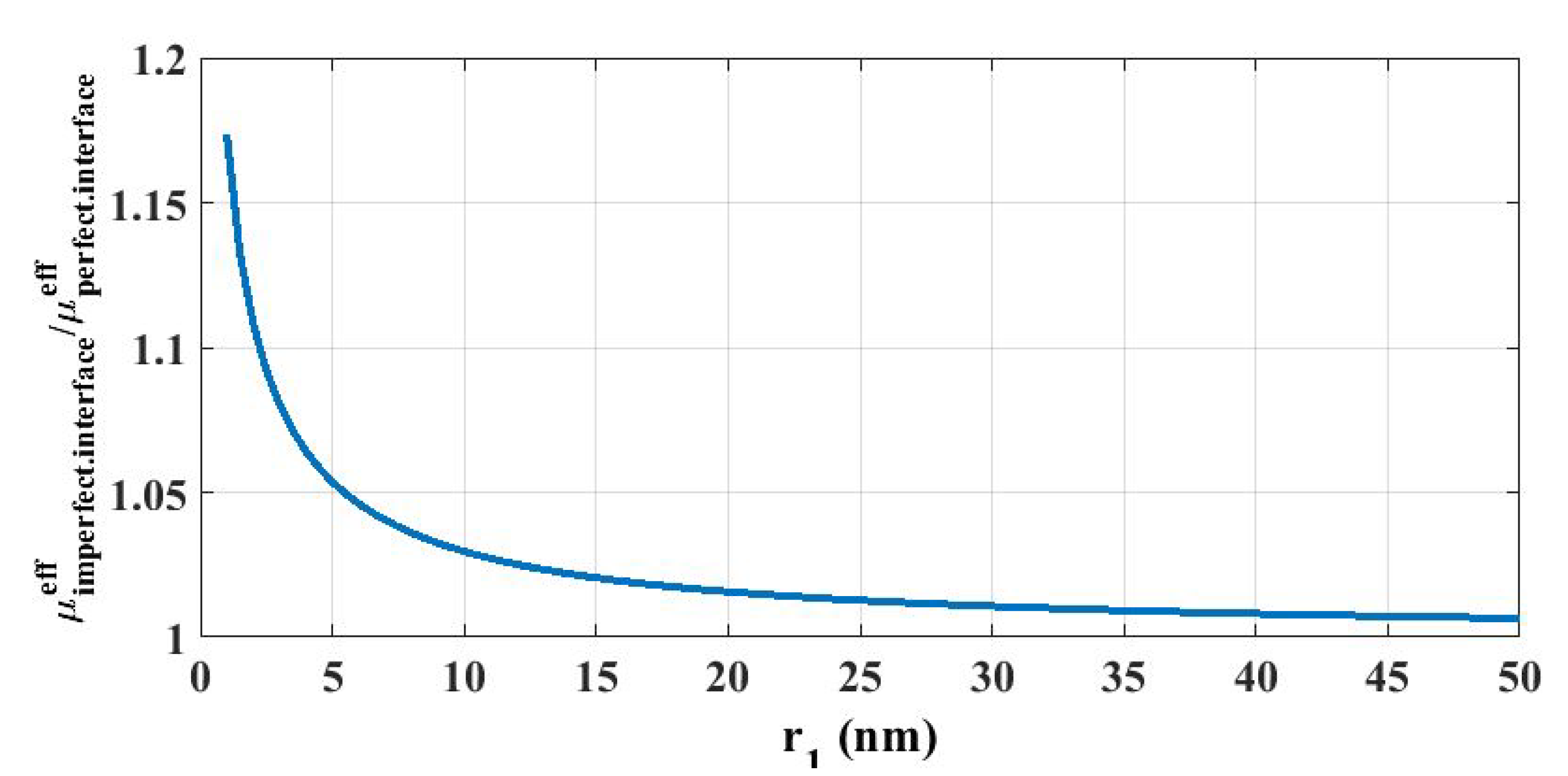Multiscale Analysis of Elastic Properties of Nano-Reinforced Materials Exhibiting Surface Effects. Application for Determination of Effective Shear Modulus
Abstract
:1. Introduction
2. Imperfect Interface Model
2.1. Geometric Description of Interface
2.2. Perfect Elastic Interface
- Continuity of the displacement field
- Continuity of the stress vector
2.3. Imperfect Elastic Interface
- Continuity of the displacement fieldSimilarly, when the displacement field is continuous at the interface, we obtain the continuity relationship of surface deformation at the interface using Equation (17)
- Discontinuity of the stress vector (see [31])with being the surface divergence operator, and the stress tensor of the interface. The stress vector is no longer continuous at the interface. The following relation represents this discontinuity (see Equation (18))
3. Homogenization of Heterogeneous Materials Presenting an Interface
3.1. Description of Microstructure
3.2. Interface Condition
3.3. Generalized Self-Consistent Scheme
3.4. Boundary Conditions for Determination of Effective Shear Modulus
4. Explicit Calculation to Determine Effective Shear Modulus
5. Numerical Application
5.1. Input Parameters for Numerical Application
5.2. Surface Effect on Effective Shear Modulus
6. Conclusions
Funding
Conflicts of Interest
Appendix A. Projection Operators
Appendix B. Elastic Moduli κ and μ
References
- Matthews, F.L.; Rawlings, R.D. Composite Materials: Engineering and Science; Woodhead Publishing: Cambridge, UK, 1999. [Google Scholar]
- Le, T.-T. Prediction of tensile strength of polymer carbon nanotube composites using practical machine learning method. J. Compos. Mater. 2020. [Google Scholar] [CrossRef]
- Staber, B.; Guilleminot, J.; Soize, C.; Michopoulos, J.; Iliopoulos, A. Stochastic modeling and identification of a hyperelastic constitutive model for laminated composites. Comput. Methods Appl. Mech. Eng. 2019, 347, 425–444. [Google Scholar] [CrossRef] [Green Version]
- Le, T.-T. Modélisation Stochastique, en Mécanique des Milieux Continus, de L’interphase Inclusion-Matrice à Partir de Simulations en Dynamique Moléculaire. Ph.D. Thesis, University of Paris-Est Marne-la-Vallée, Paris, France, October 2015. [Google Scholar]
- Ajayan, P.M.; Schadler, L.S.; Braun, P.V.; Keblinski, P. Nanocomposite Science and Technology; Wiley-VCH Verlag GmbH: Weinheim, Germany; Chichester, UK, 2015. [Google Scholar]
- Duong, H.T.; Phan, H.C.; Le, T.-T.; Bui, N.D. Optimization design of rectangular concrete-filled steel tube short columns with Balancing Composite Motion Optimization and data-driven model. Structures 2020, 28, 757–765. [Google Scholar] [CrossRef]
- Le, T.-T. Practical Machine Learning-based Prediction Model for Axial Capacity of Square CFST Columns. Mech. Adv. Mater. Struct. 2020, 2020, 8832522. [Google Scholar]
- Hussain, F.; Hojjati, M.; Okamoto, M.; Gorga, R.E. Review article: Polymer-matrix Nanocomposites, Processing, Manufacturing, and Application: An Overview. J. Compos. Mater. 2006, 40, 1511–1575. [Google Scholar] [CrossRef]
- Hanemann, T.; Szabó, D.V. Polymer-Nanoparticle Composites: From Synthesis to Modern Applications. Materials 2010, 3, 3468–3517. [Google Scholar] [CrossRef]
- Papon, A.; Saalwächter, K.; Schäler, K.; Guy, L.; Lequeux, F.; Montes, H. Low-Field NMR Investigations of Nanocomposites: Polymer Dynamics and Network Effects. Macromolecules 2011, 44, 913–922. [Google Scholar] [CrossRef]
- Berriot, J.; Lequeux, F.; Monnerie, L.; Montes, H.; Long, D.; Sotta, P. Filler–elastomer interaction in model filled rubbers, a 1H NMR study. J. Non-Cryst. Solids 2002, 307–310, 719–724. [Google Scholar] [CrossRef]
- Brown, D.; Marcadon, V.; Mélé, P.; Albérola, N.D. Effect of Filler Particle Size on the Properties of Model Nanocomposites. Macromolecules 2008, 41, 1499–1511. [Google Scholar] [CrossRef]
- Ghanbari, A.; Ndoro, T.V.M.; Leroy, F.; Rahimi, M.; Böhm, M.C.; Müller-Plathe, F. Interphase Structure in Silica–Polystyrene Nanocomposites: A Coarse-Grained Molecular Dynamics Study. Macromolecules 2012, 45, 572–584. [Google Scholar] [CrossRef]
- Guilleminot, J.; Soize, C. Stochastic modeling of anisotropy in multiscale analysis of heterogeneous materials: A comprehensive overview on random matrix approaches. Mech. Mater. 2012, 44, 35–46. [Google Scholar] [CrossRef] [Green Version]
- Le, T.-T. Probabilistic modeling of surface effects in nano-reinforced materials. Comput. Mater. Sci. 2021, 186, 109987. [Google Scholar] [CrossRef]
- Le, T.-T. Probabilistic investigation of the effect of stochastic imperfect interfaces in nanocomposites. Mech. Mater. 2020, 151, 103608. [Google Scholar] [CrossRef]
- Duan, H.L.; Wang, J.; Huang, Z.P.; Luo, Z.Y. Stress concentration tensors of inhomogeneities with interface effects. Mech. Mater. 2005, 37, 723–736. [Google Scholar] [CrossRef]
- Duan, H.L.; Wang, J.; Huang, Z.P.; Karihaloo, B.L. Size-dependent effective elastic constants of solids containing nano-inhomogeneities with interface stress. J. Mech. Phys. Solids 2005, 53, 1574–1596. [Google Scholar] [CrossRef]
- Choi, J.; Shin, H.; Yang, S.; Cho, M. The influence of nanoparticle size on the mechanical properties of polymer nanocomposites and the associated interphase region: A multiscale approach. Compos. Struct. 2015, 119, 365–376. [Google Scholar] [CrossRef]
- Kim, B.; Choi, J.; Yang, S.; Yu, S.; Cho, M. Multiscale modeling of interphase in crosslinked epoxy nanocomposites. Compos. Part B Eng. 2017, 120, 128–142. [Google Scholar] [CrossRef]
- Le, T.T.; Guilleminot, J.; Soize, C. Stochastic continuum modeling of random interphases from atomistic simulations. Application to a polymer nanocomposite. Comput. Methods Appl. Mech. Eng. 2016, 303, 430–449. [Google Scholar] [CrossRef] [Green Version]
- Staber, B.; Guilleminot, J. Stochastic modeling and generation of random fields of elasticity tensors: A unified information-theoretic approach. Comptes Rendus Mécanique 2017, 345, 399–416. [Google Scholar] [CrossRef]
- Guilleminot, J.; Le, T.T.; Soize, C. Stochastic framework for modeling the linear apparent behavior of complex materials: Application to random porous materials with interphases. Acta Mech. Sin. 2013, 29, 773–782. [Google Scholar] [CrossRef] [Green Version]
- Baek, K.; Shin, H.; Yoo, T.; Cho, M. Two-step multiscale homogenization for mechanical behaviour of polymeric nanocomposites with nanoparticulate agglomerations. Compos. Sci. Technol. 2019, 179, 97–105. [Google Scholar] [CrossRef]
- Gurtin, M.E.; Murdoch, A.I. A continuum theory of elastic material surfaces. Arch. Ration. Mech. Anal. 1975, 57, 291–323. [Google Scholar] [CrossRef]
- Quang, H.L.; He, Q.C. Variational principles and bounds for elastic inhomogeneous materials with coherent imperfect interfaces. Mech. Mater. 2008, 40, 865–884. [Google Scholar] [CrossRef]
- Hashin, Z. Thin interphase/imperfect interface in elasticity with application to coated fiber composites. J. Mech. Phys. Solids 2002, 50, 2509–2537. [Google Scholar] [CrossRef]
- Hashin, Z. Thermoelastic properties of particulate composites with imperfect interface. J. Mech. Phys. Solids 1991, 39, 745–762. [Google Scholar] [CrossRef]
- Benveniste, Y. A general interface model for a three-dimensional curved thin anisotropic interphase between two anisotropic media. J. Mech. Phys. Solids 2006, 54, 708–734. [Google Scholar] [CrossRef]
- Gu, S.-T. Contributions à la Modélisation des Interfaces Imparfaites et à L’homogénéisation des Matériaux Hétérogènes. Ph.D. Thesis, Université Paris-Est, Champs-sur-Marne, France, February 2008. [Google Scholar]
- Quang, H.L.; He, Q.C. Size-dependent effective thermoelastic properties of nanocomposites with spherically anisotropic phases. J. Mech. Phys. Solids 2007, 55, 1899–1931. [Google Scholar] [CrossRef]
- Yvonnet, J.; Quang, H.L.; He, Q.C. An XFEM/level set approach to modelling surface/interface effects and to computing the size-dependent effective properties of nanocomposites. Comput. Mech. 2008, 42, 119–131. [Google Scholar] [CrossRef] [Green Version]
- Povstenko, Y.Z. Theoretical investigation of phenomena caused by heterogeneous surface tension in solids. J. Mech. Phys. Solids 1993, 41, 1499–1514. [Google Scholar] [CrossRef]
- Christensen, R.M.; Lo, K.H. Solutions for effective shear properties in three phase sphere and cylinder models. J. Mech. Phys. Solids 1979, 27, 315–330. [Google Scholar] [CrossRef]
- Marcadon, V.; Brown, D.; Hervé, E.; Mélé, P.; Albérola, N.D.; Zaoui, A. Confrontation between Molecular Dynamics and micromechanical approaches to investigate particle size effects on the mechanical behaviour of polymer nanocomposites. Comput. Mater. Sci. 2013, 79, 495–505. [Google Scholar] [CrossRef]
- Müller, P.; Saúl, A. Elastic effects on surface physics. Surf. Sci. Rep. 2004, 54, 157–258. [Google Scholar] [CrossRef]
- Shenoy, V.B. Atomistic calculations of elastic properties of metallic fcc crystal surfaces. Phys. Rev. B 2005, 71, 094104. [Google Scholar] [CrossRef] [Green Version]
- Wang, J.; Duan, H.L.; Zhang, Z.; Huang, Z.P. An anti-interpenetration model and connections between interphase and interface models in particle-reinforced composites. Int. J. Mech. Sci. 2005, 47, 701–718. [Google Scholar] [CrossRef]
- Wang, M.; Ye, W. Size-dependent elastic field of nano-inhomogeneity: From interface effect to interphase effect. Arch. Appl. Mech. 2020, 90, 2319–2333. [Google Scholar] [CrossRef]
- Douce, J.; Boilot, J.-P.; Biteau, J.; Scodellaro, L.; Jimenez, A. Effect of filler size and surface condition of nano-sized silica particles in polysiloxane coatings. Thin Solid Films 2004, 466, 114–122. [Google Scholar] [CrossRef]
- Liu, Y.Q.; Cong, H.T.; Wang, W.; Sun, C.H.; Cheng, H.M. AlN nanoparticle-reinforced nanocrystalline Al matrix composites: Fabrication and mechanical properties. Mater. Sci. Eng. A 2009, 505, 151–156. [Google Scholar] [CrossRef]
- Chabert, E. Propriétés Mécaniques de Nanocomposites à Matrice Polymère: Approche Expérimentale et Modélisation. Ph.D. Thesis, Lyon, INSA, Villeurbanne, France, January 2002. [Google Scholar]
- Vassiliou, A.; Bikiaris, D.; Chrissafis, K.; Paraskevopoulos, K.M.; Stavrev, S.Y.; Docoslis, A. Nanocomposites of isotactic polypropylene with carbon nanoparticles exhibiting enhanced stiffness, thermal stability and gas barrier properties. Compos. Sci. Technol. 2008, 68, 933–943. [Google Scholar] [CrossRef] [Green Version]
- Chung, I.; Cho, M. Recent Studies on the Multiscale Analysis of Polymer Nanocomposites. Multiscale Sci. Eng. 2019, 1, 167–195. [Google Scholar] [CrossRef] [Green Version]
- Guilleminot, J.; Soize, C. On the Statistical Dependence for the Components of Random Elasticity Tensors Exhibiting Material Symmetry Properties. J. Elast. 2013, 111, 109–130. [Google Scholar] [CrossRef] [Green Version]
- Doan, T.; Le-Quang, H.; To, Q.-D. Effective elastic stiffness of 2D materials containing nanovoids of arbitrary shape. Int. J. Eng. Sci. 2020, 150, 103234. [Google Scholar] [CrossRef]
- Le, T.-T. Analysis of elastic deformation of amorphous polyethylene in uniaxial tensile test by using molecular dynamics simulation. Comput. Methods Mater. Sci. 2020, 20, 38–44. [Google Scholar]
- Soize, C.; Desceliers, C.; Guilleminot, J.; Le, T.-T.; Nguyen, M.-T.; Perrin, G.; Allain, J.-M.; Gharbi, H.; Duhamel, D.; Funfschilling, C. Stochastic representations and statistical inverse identification for uncertainty quantification in computational mechanics. In Proceedings of the UNCECOMP 2015, 1st ECCOMAS Thematic International Conference on Uncertainty Quantification in Computational Sciences and Engineering, Crete Island, Greece, 25–27 May 2015; pp. 1–26. [Google Scholar]






Publisher’s Note: MDPI stays neutral with regard to jurisdictional claims in published maps and institutional affiliations. |
© 2020 by the author. Licensee MDPI, Basel, Switzerland. This article is an open access article distributed under the terms and conditions of the Creative Commons Attribution (CC BY) license (http://creativecommons.org/licenses/by/4.0/).
Share and Cite
Le, T.-T. Multiscale Analysis of Elastic Properties of Nano-Reinforced Materials Exhibiting Surface Effects. Application for Determination of Effective Shear Modulus. J. Compos. Sci. 2020, 4, 172. https://doi.org/10.3390/jcs4040172
Le T-T. Multiscale Analysis of Elastic Properties of Nano-Reinforced Materials Exhibiting Surface Effects. Application for Determination of Effective Shear Modulus. Journal of Composites Science. 2020; 4(4):172. https://doi.org/10.3390/jcs4040172
Chicago/Turabian StyleLe, Tien-Thinh. 2020. "Multiscale Analysis of Elastic Properties of Nano-Reinforced Materials Exhibiting Surface Effects. Application for Determination of Effective Shear Modulus" Journal of Composites Science 4, no. 4: 172. https://doi.org/10.3390/jcs4040172
APA StyleLe, T.-T. (2020). Multiscale Analysis of Elastic Properties of Nano-Reinforced Materials Exhibiting Surface Effects. Application for Determination of Effective Shear Modulus. Journal of Composites Science, 4(4), 172. https://doi.org/10.3390/jcs4040172




